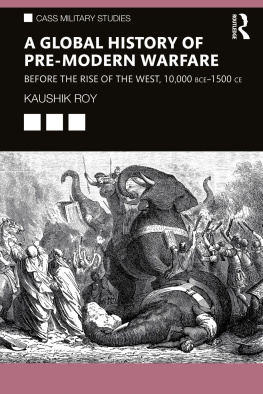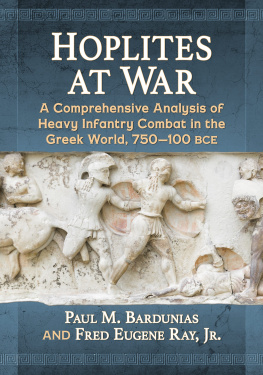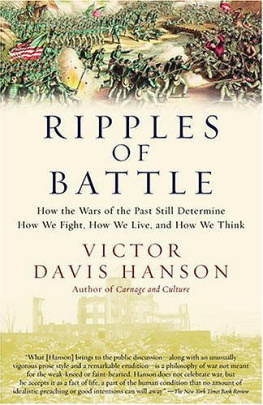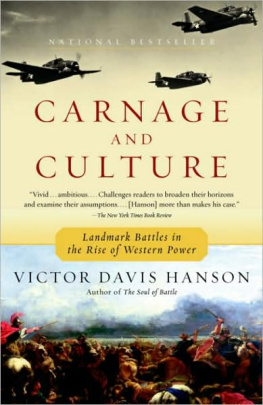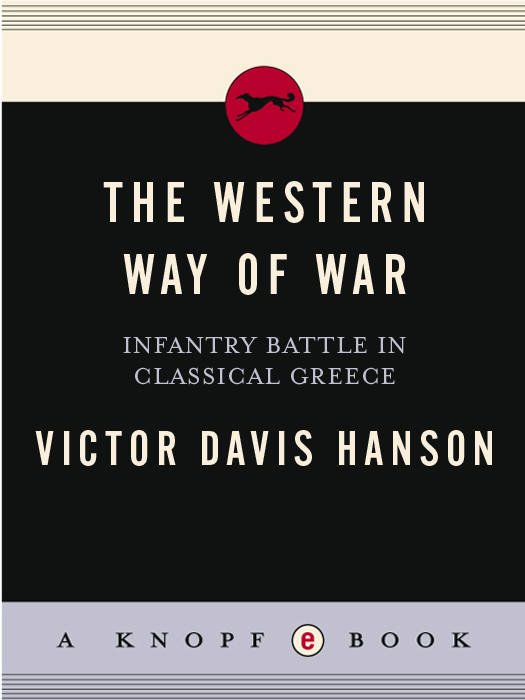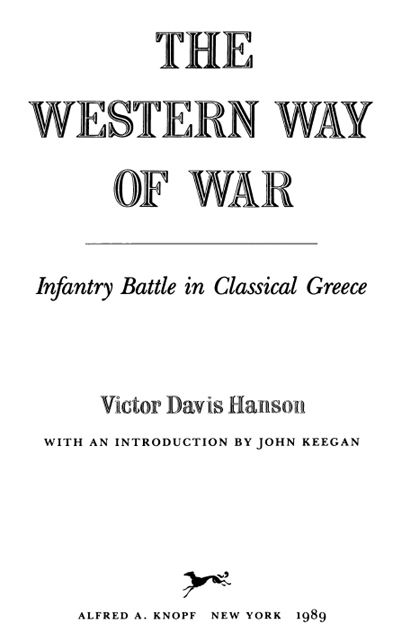THIS IS A BORZOI BOOK
PUBLISHED BY ALFRED A. KNOPF, INC.
Copyright 1989 by Victor Davis Hanson
Introduction copyright 1989 by John Keegan
All rights reserved under International and Pan-American Copyright Conventions. Published in the United States by Alfred A. Knopf, Inc., New York, and simultaneously in Canada by Random House of Canada Limited, Toronto. Distributed by Random House, Inc., New York.
Owing to limitations of space, all acknowledgments for permission to reprint previously published material may be found following the index.
Library of Congress Cataloging-in-Publication Data Hanson, Victor Davis.
The Western way of war.
Bibliography: p.
1. Military art and scienceGreeceHistory.
2. Infantry drill and tacticsHistory. I. Title.
U33.H36 1989 355.000938 88-45779
eISBN: 978-0-307-83155-2
v3.1
FOR
William Frank Hanson
Justice Pauline Davis Hanson
Contents
I
The Greeks and Modern Warfare
II
The Ordeal of the Hoplite
III
The Triumph of Will
IV
Battle!
V
Aftermath
Introduction
by John Keegan
This is a fascinating, wholly original, and deeply important book. Before I try to explain whythough any reader, expert or lay, who takes it up will need no explanation of its fascination or importancelet me say how I come to be writing this introduction, which I feel privileged to do. Some five years ago the author, Victor Hanson, whom I then did not knowand we know each other so far only through correspondencesent me the manuscript of his doctoral thesis, called Warfare and Agriculture in Classical Greece. I, like many established authors, often receive unsolicited manuscripts and find most of them embarassments. One lacks the time to read them and one lacks the nerve to tell the authors frankly, from such reading as one does, that ones attention has not been engaged.
Victor Hansons manuscript was different. In the first place, it addressed a genuinely interesting question: What was the real extent of that laying waste of crops, vines, and fruit-bearing trees so frequently mentioned by ancient historians in their accounts of warfare between the city-states? The question was interesting because the worst damage one city could do to another, after the killing of its citizen-soldiers on the battlefield, was to devastate its agriculture. But in the second place, Victor Hanson advanced a convincing answer to the question he asked. And he was able to do so not only because he was a systematic classical scholar with a sound knowledge of the appropriate texts, but also because he knew about his subject in the best of all waysthe practical way. As the son of a California grape-growing family, he had tended, pruned, and harvested vines.
As a result, he was rightly doubtful of claims that the outcome of this war or that between city-states was to leave the defeated party supine and impoverished. For he knew that the vine is a sort of weed that flourishes all the more strongly from savage cutting. And, with that in mind, he took the trouble to discover that oliveshard, scrawny, and resistant to flamedefy rapid deforestation. Devastation, he concluded, must usually have been quite limited in its effect. A defeated state, though it probably lost its grain crop and so passed a hungry winter, would not have lost its agricultural capital stockvines and olivesbecause the vines regenerated in one season; the victors could not, for both economic and military reasons, afford the time necessary to hack down the olive groves to stumps.
Had Victor Hanson left his investigation of the nature of classical warfare there, I think he would still deserve the title of a creative scholar. However, he did not. Devastation was not the central act of classical warfare. Battle was. Victor Hanson recognized that, but he found himself dissatisfiedrightly soby the analysis that modern historians advanced of the nature of battle between the ancients. They told the reader a great deal about the archaeology and iconography of battlethe weapons that excavation has found, the warrior postures that vase paintings depictbut they seemed reluctant to marry artifact with testimony, the testimony of the ancient historians themselves of the battles they had seen and sometimes fought in, to produce a picture of what ancient battle was like and, more important still, what ancient battle was for.
Some have proved more than reluctant. Numbers of Victor Hansons scholarly colleagues showed themselves downright hostile to the eventual result of his inquiry into the nature of infantry battle in classical Greece. They reacted to the chapters he circulated with the judgment that his thesis fell outside the accepted and orthodox reconstructions of Greek warfare; that it ran counter to the theories of scholarly grandees; that it did not abide safely within the confines of archaeology, iconography, and textural exegesis; that it drew upon concepts and ideas from which conventional classical scholarship held itself aloof; and that the publication of his manuscript could, therefore, only harm his professional reputation, perhapssince he was young and junior in the academic worldwith permanently damaging effect.
A less imaginative writer might have been deterred. Fortunately, Victor Hansons imagination had led him to perceive that at the root of infantry battle in classical Greece lay the value of personal courage. Courageously, therefore, he set aside the warnings of blinkered and timorous classicists and decided to publish all the same. Elisabeth Sifton, herself a scholar as well as a publisher, needed no persuasion from me, as soon as I asked her to read the manuscript, that it was a work of the highest quality. It is here presented to the general readerand the specialistso that they may come to a similar conclusion about its worth.
I delight in Victor Hansons book for two principal reasons. The first is that it is written with the greatest imagination. That is not to say the picture of Greek warfare he offers is an imaginary one. On the contrary, everything he writes is founded upon strict examination of the evidencetextual, iconographic, or archaeological. But his examination is formed by the same powers of imagination, now focused on the human side of warfare, that in his earlier book he brought from his practical experience as a viniculturist to its material aspects. Thus, while he thinks it important to tell us a great deal about the form and construction of Greek armor, he does not think that form and construction exhaust the subject. As he points out, armor was not a thing in itself; it was an appurtenance of the human body. And there are limits to the weight and discomfort of appurtenances that a human body can bearlimits to be measured not only by the index of immediate physical strength but also by that of stamina and endurance. Thus, for example, when we calculate the weight of a hoplites shield, we must think of how much muscular effort he had to put forth to support it, and for how long he could sustain that muscular effort. In doing so we begin to be able to estimate the duration of those clashes between phalanxes of hoplites that figure so frequently in the histories of Thucydides and Xenophon. And as soon as we can begin to impose a dimension of time upon the accounts of ancient historians, we prepare ourselves also to make calculations about the speed at which phalanxes moved, the distances they covered in maneuver, and all the other factors that transform an ancient source from a literary record to a scientific text.


